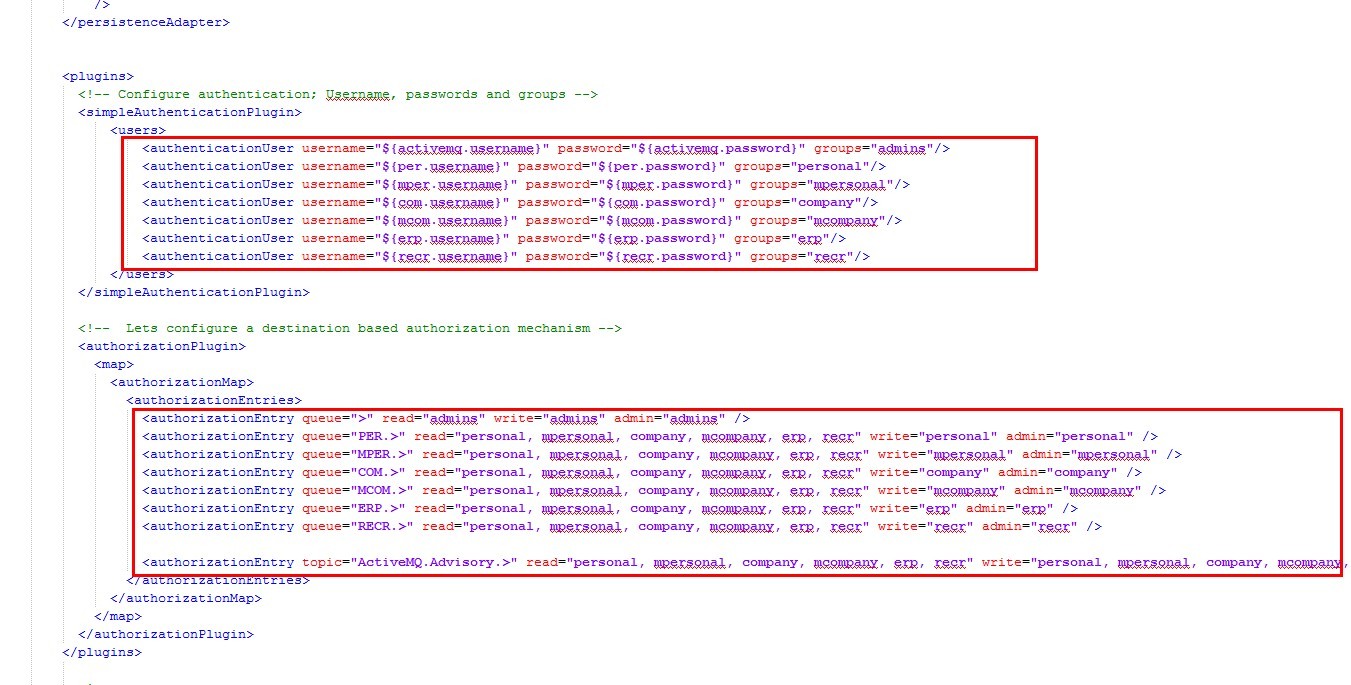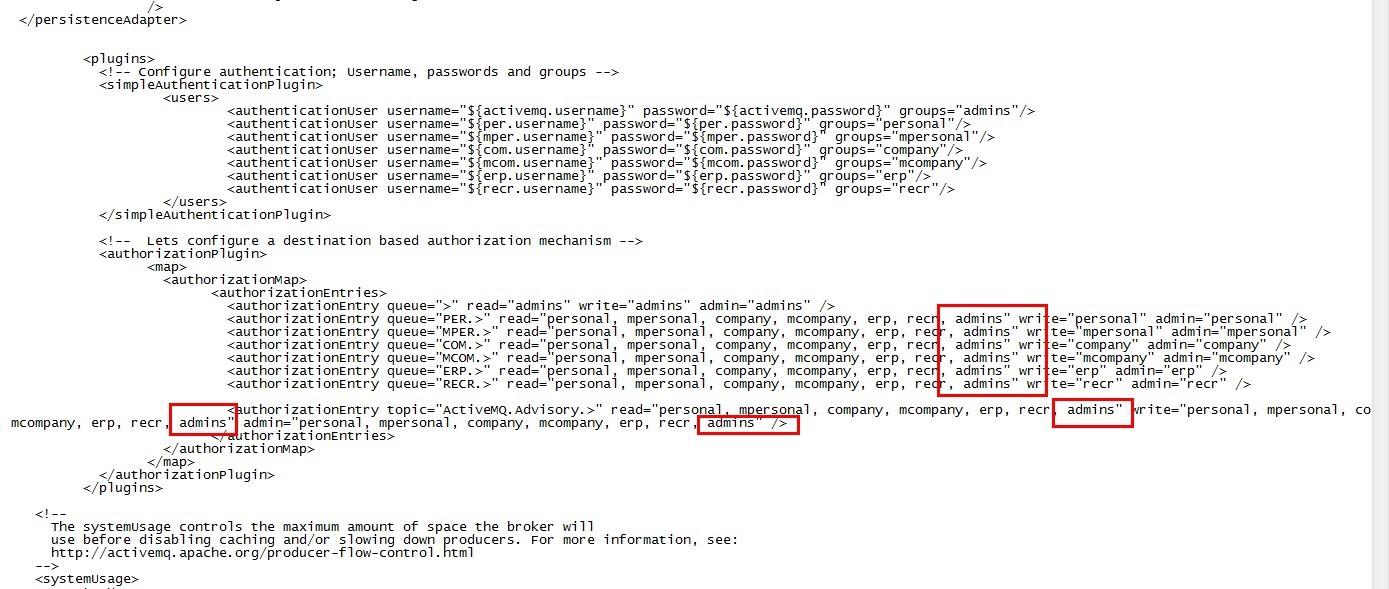修改文件%ACTIVEMQ_BASE%/conf/activemq.xml,用户名密码储存在文件%ACTIVEMQ_BASE%/conf/credentials.properties中,

activemq.xml详细如下:
<!--
Licensed to the Apache Software Foundation (ASF) under one or more
contributor license agreements. See the NOTICE file distributed with
this work for additional information regarding copyright ownership.
The ASF licenses this file to You under the Apache License, Version 2.0
(the "License"); you may not use this file except in compliance with
the License. You may obtain a copy of the License at
http://www.apache.org/licenses/LICENSE-2.0
Unless required by applicable law or agreed to in writing, software
distributed under the License is distributed on an "AS IS" BASIS,
WITHOUT WARRANTIES OR CONDITIONS OF ANY KIND, either express or implied.
See the License for the specific language governing permissions and
limitations under the License.
-->
<!-- START SNIPPET: example -->
<beans
xmlns="http://www.springframework.org/schema/beans"
xmlns:xsi="http://www.w3.org/2001/XMLSchema-instance"
xsi:schemaLocation="http://www.springframework.org/schema/beans http://www.springframework.org/schema/beans/spring-beans.xsd
http://activemq.apache.org/schema/core http://activemq.apache.org/schema/core/activemq-core.xsd">
<!-- Allows us to use system properties as variables in this configuration file -->
<bean class="org.springframework.beans.factory.config.PropertyPlaceholderConfigurer">
<property name="locations">
<value>file:${activemq.conf}/credentials.properties</value>
</property>
</bean>
<!-- Allows log searching in hawtio console -->
<bean id="logQuery" class="org.fusesource.insight.log.log4j.Log4jLogQuery"
lazy-init="false" scope="singleton"
init-method="start" destroy-method="stop">
</bean>
<!--
The <broker> element is used to configure the ActiveMQ broker.
-->
<broker xmlns="http://activemq.apache.org/schema/core" brokerName="localhost" dataDirectory="${activemq.data}" useJmx="true">
<destinationPolicy>
<policyMap>
<policyEntries>
<policyEntry queue=">" producerFlowControl="true" memoryLimit="1mb">
<!-- The constantPendingMessageLimitStrategy is used to prevent
slow topic consumers to block producers and affect other consumers
by limiting the number of messages that are retained
For more information, see:
http://activemq.apache.org/slow-consumer-handling.html
-->
<!-- 分发策略 -->
<dispatchPolicy>
<!-- 按顺序分发 -->
<strictOrderDispatchPolicy/>
</dispatchPolicy>
<!-- 恢复策略-->
<subscriptionRecoveryPolicy>
<!-- 只恢复最后一个message -->
<lastImageSubscriptionRecoveryPolicy/>
</subscriptionRecoveryPolicy>
<pendingQueuePolicy>
<!-- 首先在内存中保存消息的引用,如果内存使用量达到上限,那么会把消息引用保存到临时文件中 -->
<fileQueueCursor/>
</pendingQueuePolicy>
<pendingMessageLimitStrategy>
<constantPendingMessageLimitStrategy limit="1000"/>
</pendingMessageLimitStrategy>
</policyEntry>
<!-- 个人简历 -->
<policyEntry queue="PER.>" producerFlowControl="true" memoryLimit="10mb">
<!-- The constantPendingMessageLimitStrategy is used to prevent
slow topic consumers to block producers and affect other consumers
by limiting the number of messages that are retained
For more information, see:
http://activemq.apache.org/slow-consumer-handling.html
-->
<!-- 分发策略 -->
<dispatchPolicy>
<!-- 按顺序分发 -->
<strictOrderDispatchPolicy/>
</dispatchPolicy>
<!-- 恢复策略-->
<subscriptionRecoveryPolicy>
<!-- 只恢复最后一个message -->
<lastImageSubscriptionRecoveryPolicy/>
</subscriptionRecoveryPolicy>
<pendingQueuePolicy>
<!-- 首先在内存中保存消息的引用,如果内存使用量达到上限,那么会把消息引用保存到临时文件中 -->
<fileQueueCursor/>
</pendingQueuePolicy>
<pendingMessageLimitStrategy>
<constantPendingMessageLimitStrategy limit="1000"/>
</pendingMessageLimitStrategy>
</policyEntry>
<!-- 企业 -->
<policyEntry queue="COM.>" producerFlowControl="true" memoryLimit="10mb">
<!-- The constantPendingMessageLimitStrategy is used to prevent
slow topic consumers to block producers and affect other consumers
by limiting the number of messages that are retained
For more information, see:
http://activemq.apache.org/slow-consumer-handling.html
-->
<!-- 分发策略 -->
<dispatchPolicy>
<!-- 按顺序分发 -->
<strictOrderDispatchPolicy/>
</dispatchPolicy>
<!-- 恢复策略-->
<subscriptionRecoveryPolicy>
<!-- 只恢复最后一个message -->
<lastImageSubscriptionRecoveryPolicy/>
</subscriptionRecoveryPolicy>
<pendingQueuePolicy>
<!-- 首先在内存中保存消息的引用,如果内存使用量达到上限,那么会把消息引用保存到临时文件中 -->
<fileQueueCursor/>
</pendingQueuePolicy>
<pendingMessageLimitStrategy>
<constantPendingMessageLimitStrategy limit="1000"/>
</pendingMessageLimitStrategy>
</policyEntry>
<!-- 招聘会 -->
<policyEntry queue="RECR.>" producerFlowControl="true" memoryLimit="10mb">
<!-- The constantPendingMessageLimitStrategy is used to prevent
slow topic consumers to block producers and affect other consumers
by limiting the number of messages that are retained
For more information, see:
http://activemq.apache.org/slow-consumer-handling.html
-->
<!-- 分发策略 -->
<dispatchPolicy>
<!-- 按顺序分发 -->
<strictOrderDispatchPolicy/>
</dispatchPolicy>
<!-- 恢复策略-->
<subscriptionRecoveryPolicy>
<!-- 只恢复最后一个message -->
<lastImageSubscriptionRecoveryPolicy/>
</subscriptionRecoveryPolicy>
<pendingQueuePolicy>
<!-- 首先在内存中保存消息的引用,如果内存使用量达到上限,那么会把消息引用保存到临时文件中 -->
<fileQueueCursor/>
</pendingQueuePolicy>
<pendingMessageLimitStrategy>
<constantPendingMessageLimitStrategy limit="1000"/>
</pendingMessageLimitStrategy>
</policyEntry>
<!-- 微招聘 -->
<policyEntry queue="MCOM.>" producerFlowControl="true" memoryLimit="10mb">
<!-- The constantPendingMessageLimitStrategy is used to prevent
slow topic consumers to block producers and affect other consumers
by limiting the number of messages that are retained
For more information, see:
http://activemq.apache.org/slow-consumer-handling.html
-->
<!-- 分发策略 -->
<dispatchPolicy>
<!-- 按顺序分发 -->
<strictOrderDispatchPolicy/>
</dispatchPolicy>
<!-- 恢复策略-->
<subscriptionRecoveryPolicy>
<!-- 只恢复最后一个message -->
<lastImageSubscriptionRecoveryPolicy/>
</subscriptionRecoveryPolicy>
<pendingQueuePolicy>
<!-- 首先在内存中保存消息的引用,如果内存使用量达到上限,那么会把消息引用保存到临时文件中 -->
<fileQueueCursor/>
</pendingQueuePolicy>
<pendingMessageLimitStrategy>
<constantPendingMessageLimitStrategy limit="1000"/>
</pendingMessageLimitStrategy>
</policyEntry>
<!-- 微求职 -->
<policyEntry queue="MPER.>" producerFlowControl="true" memoryLimit="10mb">
<!-- The constantPendingMessageLimitStrategy is used to prevent
slow topic consumers to block producers and affect other consumers
by limiting the number of messages that are retained
For more information, see:
http://activemq.apache.org/slow-consumer-handling.html
-->
<!-- 分发策略 -->
<dispatchPolicy>
<!-- 按顺序分发 -->
<strictOrderDispatchPolicy/>
</dispatchPolicy>
<!-- 恢复策略-->
<subscriptionRecoveryPolicy>
<!-- 只恢复最后一个message -->
<lastImageSubscriptionRecoveryPolicy/>
</subscriptionRecoveryPolicy>
<pendingQueuePolicy>
<!-- 首先在内存中保存消息的引用,如果内存使用量达到上限,那么会把消息引用保存到临时文件中 -->
<fileQueueCursor/>
</pendingQueuePolicy>
<pendingMessageLimitStrategy>
<constantPendingMessageLimitStrategy limit="1000"/>
</pendingMessageLimitStrategy>
</policyEntry>
<!-- 后台 -->
<policyEntry queue="ERP.>" producerFlowControl="true" memoryLimit="10mb">
<!-- The constantPendingMessageLimitStrategy is used to prevent
slow topic consumers to block producers and affect other consumers
by limiting the number of messages that are retained
For more information, see:
http://activemq.apache.org/slow-consumer-handling.html
-->
<!-- 分发策略 -->
<dispatchPolicy>
<!-- 按顺序分发 -->
<strictOrderDispatchPolicy/>
</dispatchPolicy>
<!-- 恢复策略-->
<subscriptionRecoveryPolicy>
<!-- 只恢复最后一个message -->
<lastImageSubscriptionRecoveryPolicy/>
</subscriptionRecoveryPolicy>
<pendingQueuePolicy>
<!-- 首先在内存中保存消息的引用,如果内存使用量达到上限,那么会把消息引用保存到临时文件中 -->
<fileQueueCursor/>
</pendingQueuePolicy>
<pendingMessageLimitStrategy>
<constantPendingMessageLimitStrategy limit="1000"/>
</pendingMessageLimitStrategy>
</policyEntry>
</policyEntries>
</policyMap>
</destinationPolicy>
<!--
The managementContext is used to configure how ActiveMQ is exposed in
JMX. By default, ActiveMQ uses the MBean server that is started by
the JVM. For more information, see:
http://activemq.apache.org/jmx.html
-->
<managementContext>
<managementContext createConnector="false"/>
</managementContext>
<!--
Configure message persistence for the broker. The default persistence
mechanism is the KahaDB store (identified by the kahaDB tag).
For more information, see:
http://activemq.apache.org/persistence.html
-->
<persistenceAdapter>
<kahaDB directory="E:/activemq_data"
enableJournalDiskSyncs="false"
indexWriteBatchSize="1000"
indexCacheSize="10000"
journalMaxFileLength="32mb"
/>
</persistenceAdapter>
<plugins>
<!-- Configure authentication; Username, passwords and groups -->
<simpleAuthenticationPlugin>
<users>
<authenticationUser username="${activemq.username}" password="${activemq.password}" groups="admins"/>
<authenticationUser username="${per.username}" password="${per.password}" groups="personal"/>
<authenticationUser username="${mper.username}" password="${mper.password}" groups="mpersonal"/>
<authenticationUser username="${com.username}" password="${com.password}" groups="company"/>
<authenticationUser username="${mcom.username}" password="${mcom.password}" groups="mcompany"/>
<authenticationUser username="${erp.username}" password="${erp.password}" groups="erp"/>
<authenticationUser username="${recr.username}" password="${recr.password}" groups="recr"/>
</users>
</simpleAuthenticationPlugin>
<!-- Lets configure a destination based authorization mechanism -->
<authorizationPlugin>
<map>
<authorizationMap>
<authorizationEntries>
<authorizationEntry queue=">" read="admins" write="admins" admin="admins" />
<authorizationEntry queue="PER.>" read="personal, mpersonal, company, mcompany, erp, recr" write="personal" admin="personal" />
<authorizationEntry queue="MPER.>" read="personal, mpersonal, company, mcompany, erp, recr" write="mpersonal" admin="mpersonal" />
<authorizationEntry queue="COM.>" read="personal, mpersonal, company, mcompany, erp, recr" write="company" admin="company" />
<authorizationEntry queue="MCOM.>" read="personal, mpersonal, company, mcompany, erp, recr" write="mcompany" admin="mcompany" />
<authorizationEntry queue="ERP.>" read="personal, mpersonal, company, mcompany, erp, recr" write="erp" admin="erp" />
<authorizationEntry queue="RECR.>" read="personal, mpersonal, company, mcompany, erp, recr" write="recr" admin="recr" />
<authorizationEntry topic="ActiveMQ.Advisory.>" read="personal, mpersonal, company, mcompany, erp, recr" write="personal, mpersonal, company, mcompany, erp, recr" admin="personal, mpersonal, company, mcompany, erp, recr" />
</authorizationEntries>
</authorizationMap>
</map>
</authorizationPlugin>
</plugins>
<!--
The systemUsage controls the maximum amount of space the broker will
use before disabling caching and/or slowing down producers. For more information, see:
http://activemq.apache.org/producer-flow-control.html
-->
<systemUsage>
<systemUsage>
<memoryUsage>
<memoryUsage percentOfJvmHeap="100" />
</memoryUsage>
<storeUsage>
<storeUsage limit="1 gb"/>
</storeUsage>
<tempUsage>
<tempUsage limit="100 mb"/>
</tempUsage>
</systemUsage>
</systemUsage>
<!--
The transport connectors expose ActiveMQ over a given protocol to
clients and other brokers. For more information, see:
http://activemq.apache.org/configuring-transports.html
-->
<transportConnectors>
<!-- DOS protection, limit concurrent connections to 1000 and frame size to 100MB -->
<transportConnector name="openwire" uri="tcp://0.0.0.0:61616?maximumConnections=1000&wireFormat.maxFrameSize=104857600"/>
<transportConnector name="amqp" uri="amqp://0.0.0.0:5672?maximumConnections=1000&wireFormat.maxFrameSize=104857600"/>
<transportConnector name="stomp" uri="stomp://0.0.0.0:61613?maximumConnections=1000&wireFormat.maxFrameSize=104857600"/>
<transportConnector name="mqtt" uri="mqtt://0.0.0.0:1883?maximumConnections=1000&wireFormat.maxFrameSize=104857600"/>
<transportConnector name="ws" uri="ws://0.0.0.0:61614?maximumConnections=1000&wireFormat.maxFrameSize=104857600"/>
</transportConnectors>
<!-- destroy the spring context on shutdown to stop jetty -->
<shutdownHooks>
<bean xmlns="http://www.springframework.org/schema/beans" class="org.apache.activemq.hooks.SpringContextHook" />
</shutdownHooks>
</broker>
<!--
Enable web consoles, REST and Ajax APIs and demos
The web consoles requires by default login, you can disable this in the jetty.xml file
Take a look at ${ACTIVEMQ_HOME}/conf/jetty.xml for more details
-->
<import resource="jetty.xml"/>
</beans>
<!-- END SNIPPET: example -->
credentials.properties详细如下:
## ---------------------------------------------------------------------------
## Licensed to the Apache Software Foundation (ASF) under one or more
## contributor license agreements. See the NOTICE file distributed with
## this work for additional information regarding copyright ownership.
## The ASF licenses this file to You under the Apache License, Version 2.0
## (the "License"); you may not use this file except in compliance with
## the License. You may obtain a copy of the License at
##
## http://www.apache.org/licenses/LICENSE-2.0
##
## Unless required by applicable law or agreed to in writing, software
## distributed under the License is distributed on an "AS IS" BASIS,
## WITHOUT WARRANTIES OR CONDITIONS OF ANY KIND, either express or implied.
## See the License for the specific language governing permissions and
## limitations under the License.
## ---------------------------------------------------------------------------
# Defines credentials that will be used by components (like web console) to access the broker
activemq.username=***
activemq.password=***
per.username=***
per.password=***
mper.username=***
mper.password=***
com.username=***
com.password=***
mcom.username=***
mcom.password=***
erp.username=***
erp.password=***
recr.username=***
recr.password=***
以上配置今天发现队列监控出现异常,最后查到问题出现在这里:

由于队列监控项目admin里使用的账户为system/manager(webappsadminWEB-INFwebconsole-embedded.xml

),属于admins群组,需要加上权限。